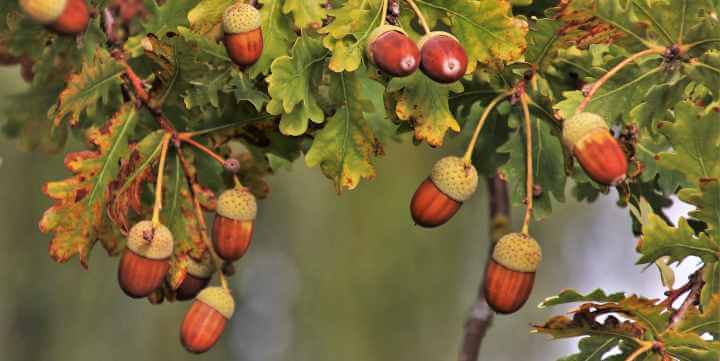Welcome to our guide on oak trees! If you’re planning to add an oak tree to your garden, understanding the different types available is essential.
Oak trees are renowned for their hardiness and are predominantly found in the Northern Hemisphere’s forests.
In this guide, we’ll focus on how to identify oak tree species by their leaves, a key characteristic for any gardener or nature enthusiast.
You’ll learn about the two primary types of oak trees – White Oak Trees and Red Oak Trees – and how their unique leaf patterns can help you make an informed choice for your garden.
We’ll delve into other distinguishing features such as bark, acorns, and overall shape, providing you with a well-rounded understanding of these majestic trees.
Ready to learn how to identify oak tree by leaves and more? Let’s dive into the world of oak trees and discover the ideal species for your garden!
Understanding Oak Trees: Key Characteristics
Oak trees, with over 440 species worldwide and more than 50 native to North America, are as diverse as they are majestic.
When considering an oak tree for your garden, it’s essential to note their size requirements.
These expansive trees, part of the Deciduous Range, shed their leaves in fall, though some varieties are evergreen, maintaining their foliage year-round.
The size of oak trees is particularly striking, with some reaching up to 100 feet in height and branches spreading as wide as 41 meters.
Their impressive stature not only adds aesthetic value to landscapes but also serves as a natural haven for wildlife.
An interesting aspect of oak trees is their fruit – the acorn, also known as the oak nut.
These fruits play a crucial role in wildlife ecosystems and are a key feature in identifying oak tree species.
In the upcoming sections, we’ll explore how the distinct characteristics of acorns, along with leaves and bark, can help you accurately identify oak tree species for your garden.
Different Varieties of Oak Trees:
The vast world of oak trees is primarily categorized into two types: Red Oak Trees and White Oak Trees.
Each type possesses distinct characteristics, crucial for anyone looking to identify oak tree by leaves.
White Oak Trees are known for their rounded leaf lobes, which notably lack bristles.
This group includes a range of species under the genus Quercus and subgenus Leucobalanus.
Their leaves, aside from the rounded lobes, are often a vibrant green, providing a lush look in any garden setting.
On the other hand, Red Oak Trees are recognizable by their darker barks and leaves with pointed ends, typically adorned with bristles.
These trees fall under the genus Quercus and subgenus Erythrobalanus.
The pointed leaves of Red Oak Trees not only aid in identification but also add a distinct texture to the landscape.
In the following sections, we’ll delve deeper into these two categories, examining how the unique features of their leaves can help you confidently identify oak tree species.
Identifying White Oak Trees by Leaves
White Oak Trees are distinguished by their lobed leaves with rounded edges, a defining characteristic of identifying oak tree species by leaves.
These leaves lack bristles, setting them apart from other varieties.
The acorns produced by White Oak Trees mature in a year and have a unique taste profile, being both sweet and slightly bitter.
These leaves typically measure between 13-25 cm (5″ to 10″) in length, making them a significant feature for identification.
Identifying Red Oak Trees by Leaves
In contrast, Red Oak Trees feature lobed leaves with pointed edges and tiny bristles.
This leaf structure is key for those looking to identify oak tree by leaves.
The acorns from Red Oak Trees take about two years to mature and are known for their distinctly bitter taste, which is less favored.
While the leaves of Red Oak Trees are similar in size to those of White Oak Trees, their pointed edges and bristles provide clear identification markers.
Leaf Structures in Oak Tree Identification
The leaves of oak trees are crucial for distinguishing between the different species, especially when trying to identify oak tree by leaves.
White Oak trees feature leaves with round edges and a noticeable absence of bristles.
Their lobed leaves lack pointed tips, making them easily identifiable.
Red Oak tree leaves contrast with their White Oak counterparts by having pointed edges and bristles.
This distinct structure is a reliable marker to identify Red Oak Trees.
While these leaves may vary in their overall shape, the presence of pointed edges and bristles remains consistent.
Beyond White and Red Oak species, other oak trees exhibit a range of leaf shapes, including tooth-like edges or smoother edges.
This diversity in leaf structure across oak tree species highlights the rich variety within the oak family and underscores the importance of leaf characteristics in tree identification.
Identifying Oak Trees by Bark
In addition to leaves, the bark of oak trees provides essential clues for identification.
Young oak trees typically have smooth, silvery-brownish bark.
As they age, this bark evolves into a more grooved and fissured appearance, which can be key in identifying the tree’s species.
White Oak Trees are identifiable by their light gray bark, which is a significant marker for this variety.
In contrast, the bark of Red Oak Trees is notably darker, often approaching a deep, almost black hue.
This stark difference in bark color and texture between White and Red Oak Trees serves as another valuable tool to identify oak tree species, complementing the leaf-based identification methods.
Oak Tree Identification
To identify oak tree by leaves, observe whether the leaves have rounded lobes without bristles (indicative of White Oak Trees) or pointed leaves with bristles (signifying Red Oak Trees).
The investigation doesn’t stop at the leaves. The bark color further aids in identification.
A light gray bark suggests a White Oak Tree, while a dark, almost black bark points to a Red Oak Tree.
By combining these observations – leaf shape and bark color – you can confidently determine not only if it’s an oak tree but also which specific type it is.
Acorns and Their Role in Identifying Oak Trees
Acorns, the fruit produced by oak trees, play a significant role in further identifying the species.
While acorns from different oak trees might appear similar in shape, their taste and size are distinguishing factors.
For a more complete understanding of how to identify oak tree by leaves and additional features, consider the acorns.
Acorns from White Oak Trees usually have a sweet and slightly bitter taste, while those from Red Oak Trees are characteristically more bitter and often unpalatable.
Additionally, acorns from Red Oak Trees tend to be larger compared to those of White Oak Trees.
This subtle yet distinct difference in acorn characteristics adds another layer to the identification process.
Different Types of Oak Trees
The world of oak trees is rich and diverse, encompassing a wide range of species, each with unique characteristics.
In this section, we explore various oak tree species, focusing on their leaves, bark, and acorns to aid in identification.
This detailed exploration will provide you with the knowledge needed to identify oak tree by leaves and other distinguishing features.
1. Chinkapin Oak Tree
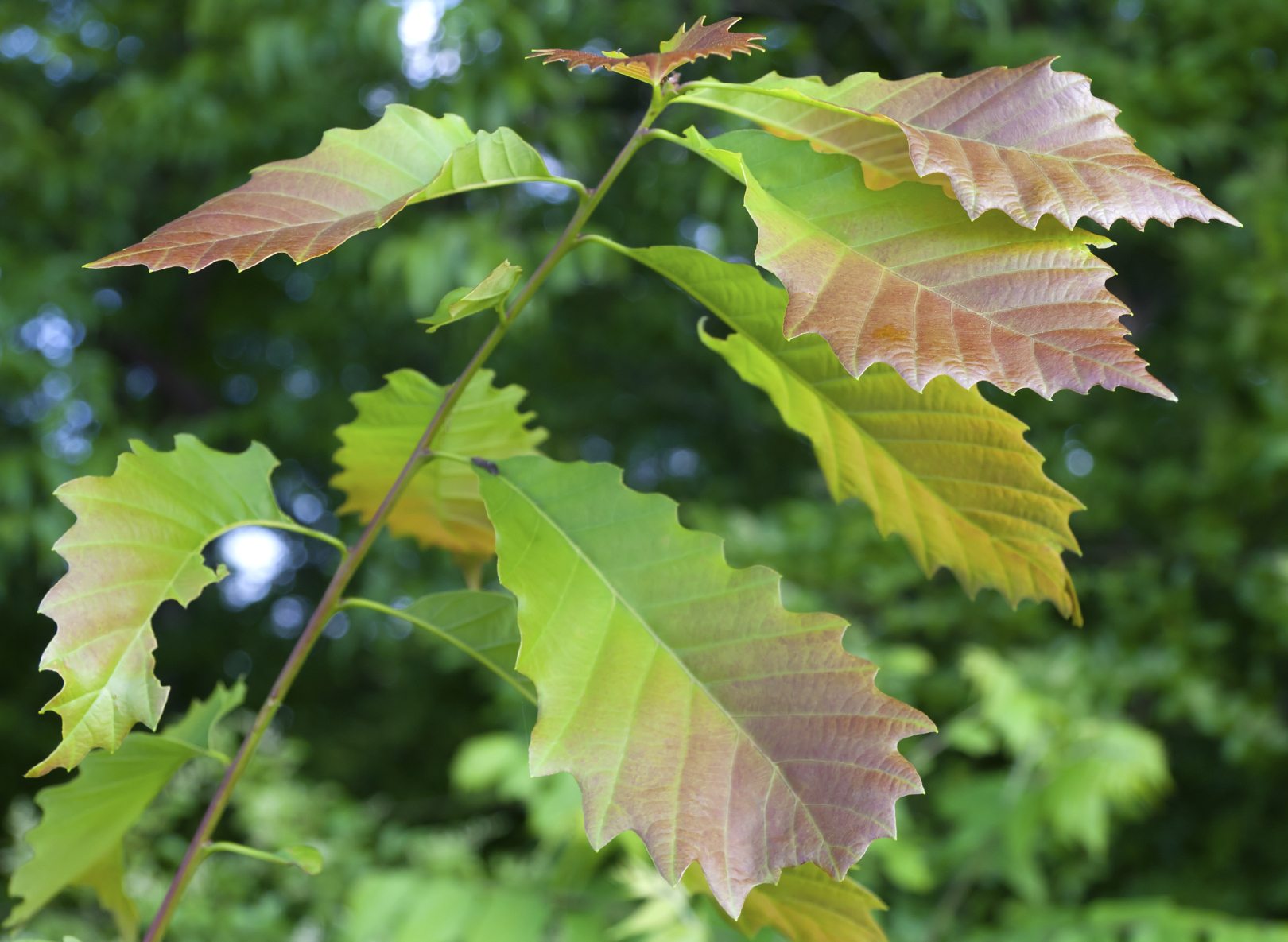
The Botanical name of the Chinkapin Oaktree is Quercus muehlenbergii.
These Oak Trees have large branches that emerge from the trunk to the surface.
The leaf growth is like the chestnut oak tree. It has pointed but not rounded teeth at the edges of the leaves.
Chinkapin Oak is a large white oak tree species and has grown between 40-100 ft.
The best thing about Chinkapin Oak Trees is that they have the sweetest Acorns among all the available white oak tree species.
You can identify the Chinkapin oak tree by its flaky gray bark and shallow fissures.
The Chinkapin oak tree has leaves with round teeth-like structures at the edges of leaves and without bristles.
The leaves look like chestnut oak tree leaves.
2. Holm Oak Tree
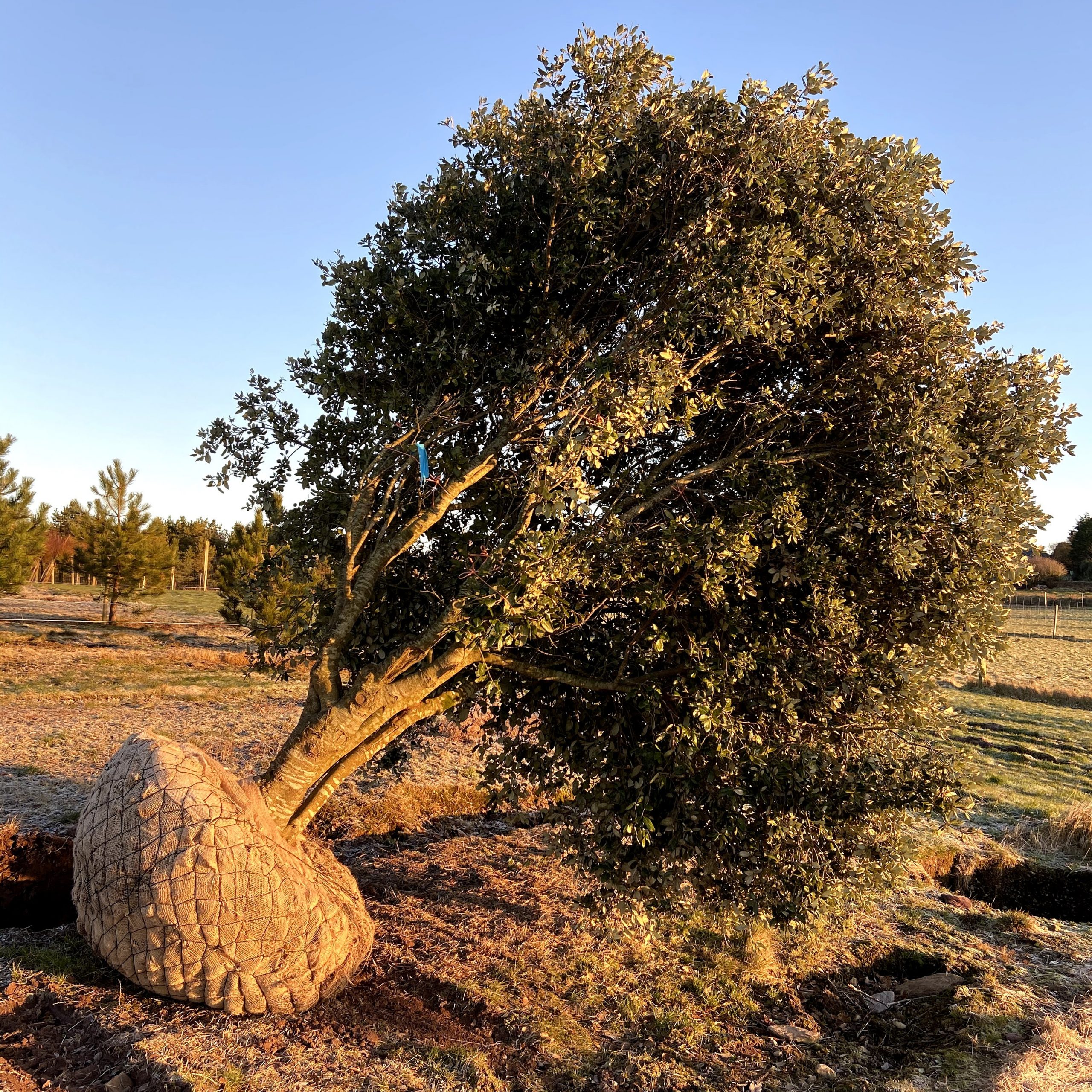
The Botanical name of the Home Oak Tree is Quercus Ilex.
Holm Oaktree is also called Evergreen Oak Tree since their leaves do not fall as per the seasons, and they are evergreen.
These Oak Trees are medium-sized Oak Trees that have grown between 68-89 ft.
Unlike other Oak Trees, these Oak trees have gray to black barks with fissures merely noticeable.
They look like cracks on a paved ground or a cemented floor.
The leaves of these Oak Trees have no lobed structure, and they have glossy looks.
Moreover, they are of lanceolate shape. So glossy leaves are the significant identification mark of these types of Oak Trees.
3. Chestnut Oak Trees
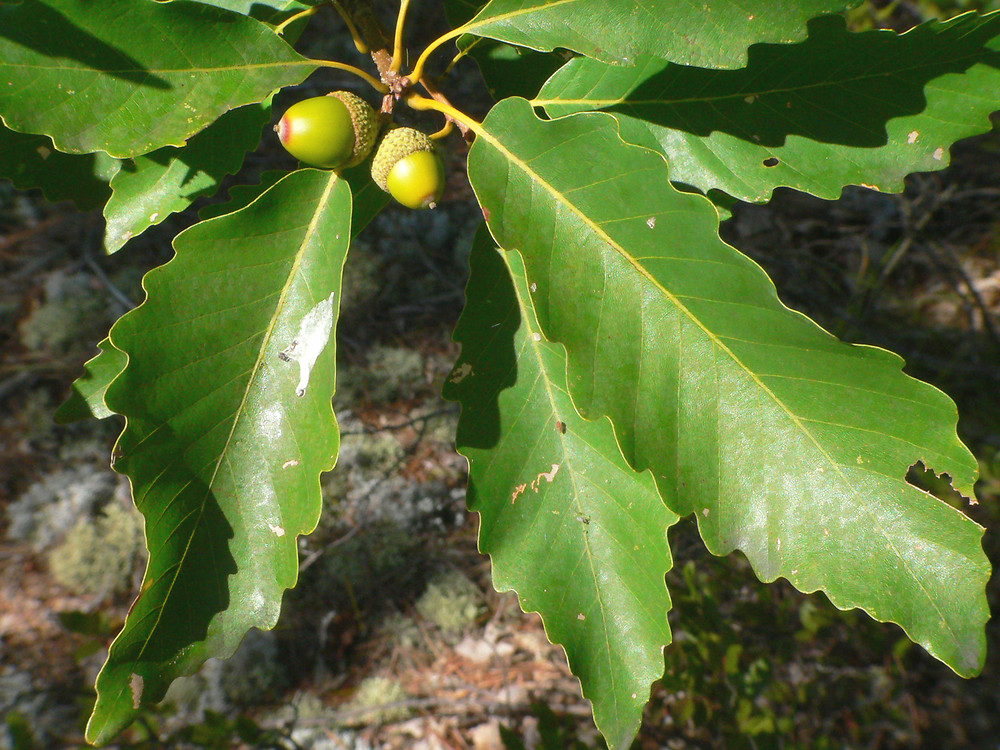
The Botanical name of the Chestnut Oak Tree is Quercus Montana.
Chestnut oak trees have significant growth on the top of them like a crown, and they have an extensive range of Foliage and branches.
These Oaktree types fall in medium-sized White Oak Trees with growth between 60-70 feet.
The Chestnut Oaks have deep fissures on them for a better identification mark along with peaked ridges.
You can quickly identify them by looking at these pointers as they have unique bark.
The leaves of Chestnut Oak Trees have bristled with tooth shapes at the edges.
They do not have lobes at the ends and have a V shape. They usually grow in clusters.
4. Oregon White Oak Trees
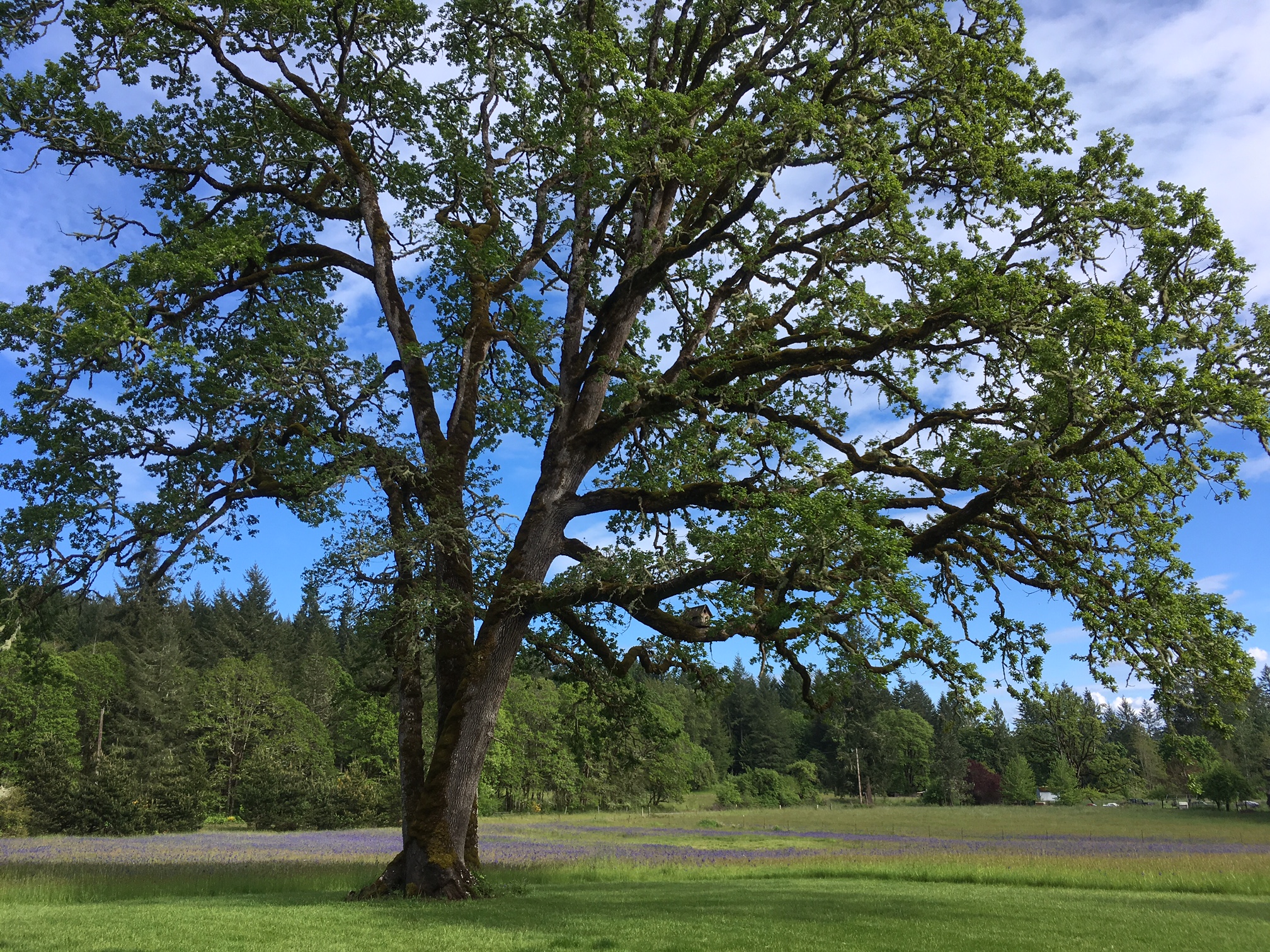
The Botanical Name of the Oregon White Oak tree is Quercus Garryana.
They can grow as large trees and shrubs in miniature landscapes in your gardens, where they grow between 10-16 ft.
They are natives of the northeast coast of North America and grow between 60-100 ft long.
The bark of these trees is usually light Gray and is heavily wrinkled with ridges at the ends.
Oregon White Oak has round-shaped leaves with a perfect “U” shape and glossy green lobes.
They have rounded tips with rounded apex as well.
5. Sand Post Oak Trees
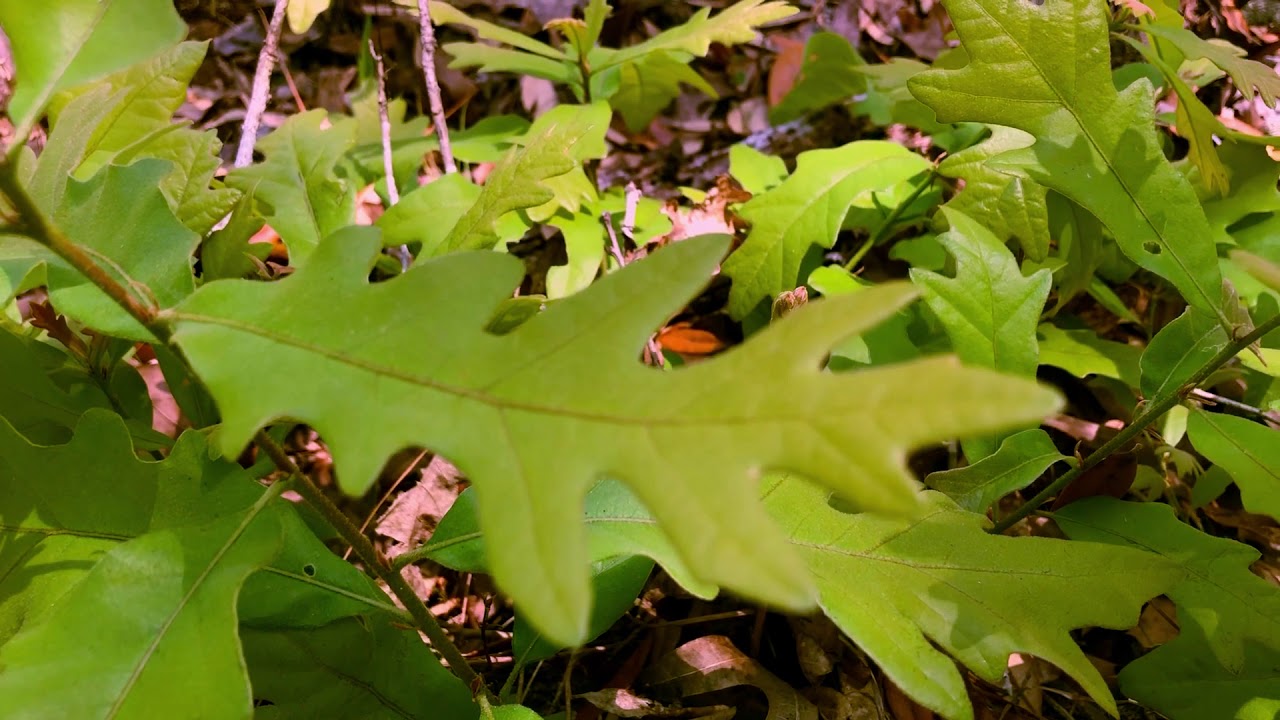
The Botanical Name of the Sand Post Oak Tree is Quercus Margaretta.
As the name suggests, they grow in sandy soil and the natives of the Southeastern states.
These are small Shrubs that grow only to a maximum of 42 ft. These are also called the smallest white oak trees.
The bark of these Oak Trees is gray and with shallow fissures. They also have ridges on them.
The leaves of these trees are deeply rounded at the ends and with rounded lobes as well.
So, you can quickly identify them with these identification points.
6. Post Oak Trees
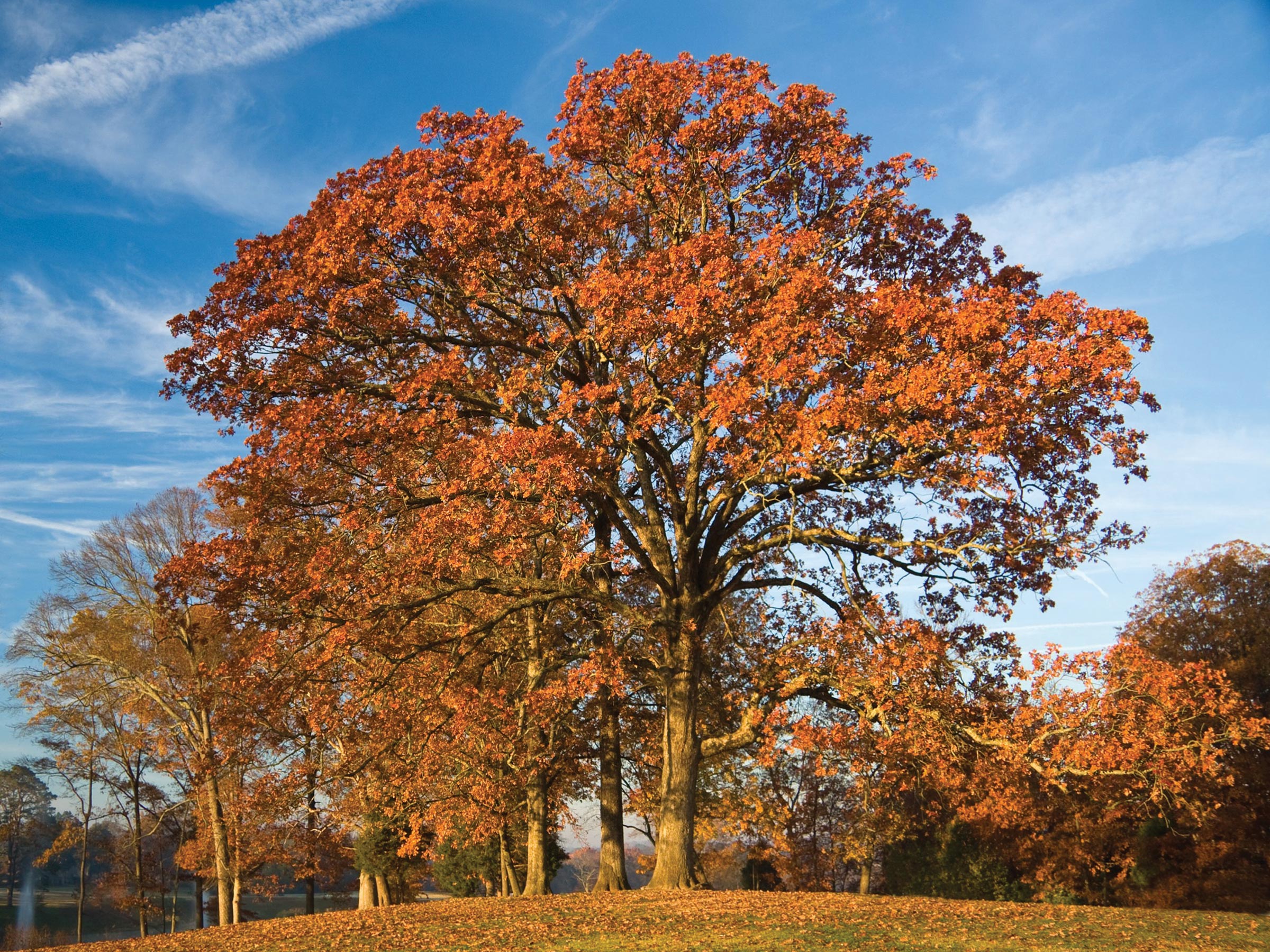
The Botanical name of the Post Oak trees is Quercus Stellata.
These oak trees are smaller species in the Oak Tree category and can grow up to 48-50 ft.
You can identify them by looking at their bark and sizeable spreading crown.
The bark of Post Oak Trees is very fissured and light gray.
The leaves of Post Oak Trees are lobed with a cross shape, just like you see in the Maltese Cross.
So, this will be the identification mark for this Tree.
7. English Oak Trees
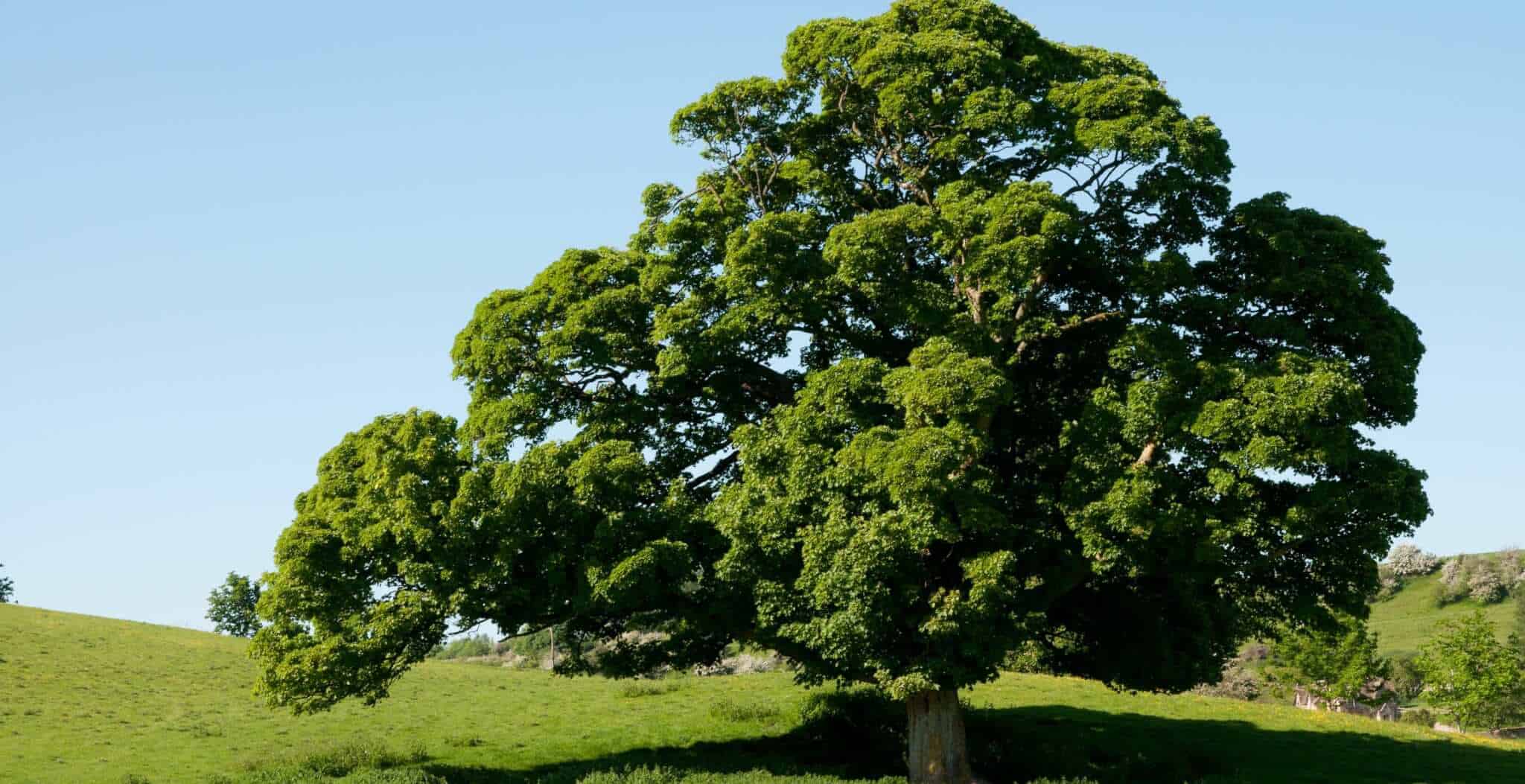
The Botanical Name of the English Oak Tree is Quercus Robur.
The English Oaktree is also known as the Majestic Oak tree with growth between 40-75ft.
They are a prevalent type of Oaktree. They can be identified easily as well when you look at their trunk.
They have a massive trunk with a diameter of 15-40 ft. So, it is the best identification pointer to keep in mind when you see and check for this type of Tree.
Also, they have an incredible growth of branches on their top. So, size matters here and is a good thing to keep in mind.
English Oak Tree has blackish color bark and deep fissuring.
They have thick branches and very thick trunks to be identified easily with a single look.
The leaves of English Oak Trees are round-shaped and small.
They do not have pointed ends but smooth ends. So, they have a standard and classic shape of the leaves with acorn-producing trees.
8. Eastern White Oak Trees
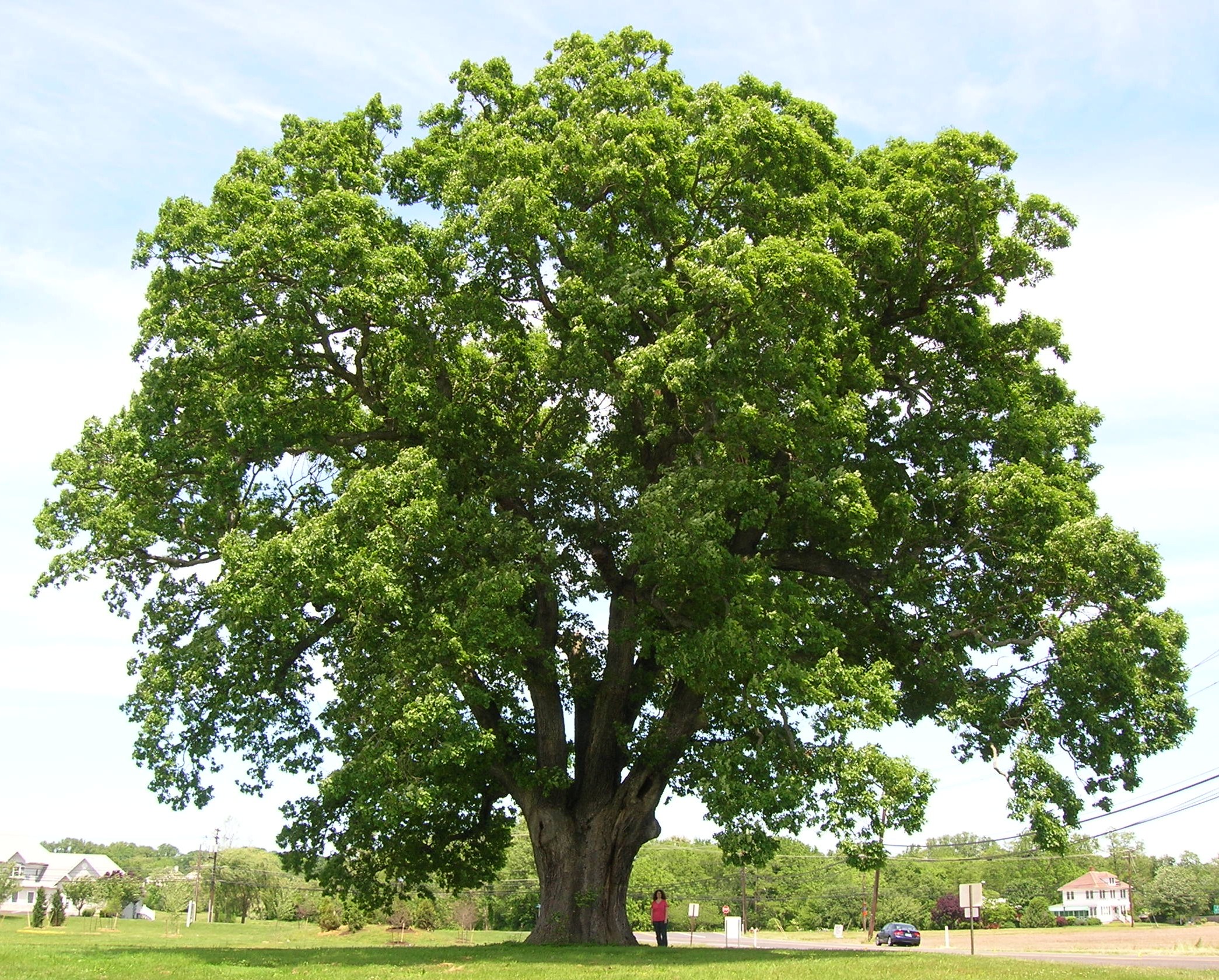
The Botanical Name of the Eastern White Oak tree is Quercus Alba.
These trees are so massive and can have a growth of up to 100 ft. Eastern White Oak is called white Oaks since they have white hardwood.
The bark of Eastern White Oak has a light grayish color with small and slight fissures.
They also have scales that overlap each other from halfway up to the trunk.
The leaves of Eastern White Oak are large with rounded lobes. They also have rounded edges at the ends.
Moreover, the leaves have large obovate structures.
9. Bur Oak Trees
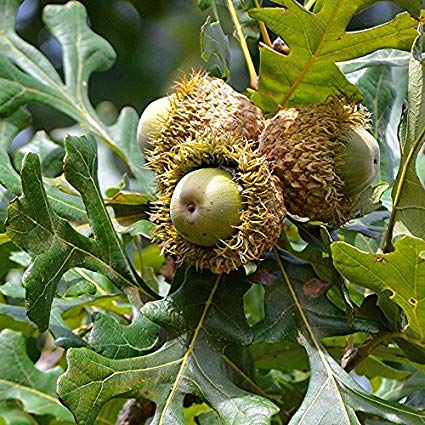
The Botanical name of the Bur Oak Tree is Quercus Macrocarpa.
The Bur Oak trees are a massive category of White Oak Trees, and they have a very massive growth as they can grow up to 100 ft.
Sometimes their growth may also cross 100 ft and go up to 165 ft.
The Bur oak is one of the Giant oaks and has a very dense structure with a trunk diameter of up to 12-13 ft.
These are slow-growing oaks and are usually found in the Northern part of America on a considerable scale.
The bark of Bur Oak trees has a medium Grayish color. They have narrow and deep fissures with scales on them.
Moreover, they have vertical ridges that are visible to everyone. This is a strong identification point to be of great value.
The leaves of Bur Oak Tree are large and of no shape at all.
They seem to be shapeless but have a massive structure with small lobes up to half of the leaves’ length.
They also have a rounded apex that can help you to recognize them.
10. Sessile Oak Trees

The Botanical Name of the Sessile Oak Tree is Quercus Petraea.
Sessile Oak Trees are large white Oak tree species, and they can grow from 70-135 ft long.
They are native to Europe and found mainly in Ireland, so they are also known as Irish Oaks.
These Oak Trees are Deciduous, and their leaves drop during the fall.
Their leaves change their color as per the season, and they turn from Olive Green to Golden Yellow during fall.
Sessile Oak Trees’ bark is very smooth during a young age, and they become fissured when they mature.
It is just like human skin as it is smooth when young and gradually becomes wrinkled when matured.
The leaves of Sessile Oak Trees are slightly lobed, and they have a teeth-like structure around the Margins.
Conclusion
In conclusion, understanding the vast array of oak tree species and their unique identification markers, including leaves, bark, and acorns, is essential for selecting the right oak tree for your garden.
With this comprehensive guide, you now have the insights to choose the perfect oak tree that not only enhances your landscape’s beauty but also suits your specific needs and preferences.
Armed with this knowledge, you’re now ready to make an informed decision about which oak tree species to plant in your garden.
Enjoy the natural beauty and unique characteristics of these majestic trees, from their diverse leaf shapes to the intriguing acorns they produce.
Comment and tell us how helpful this guide was.

